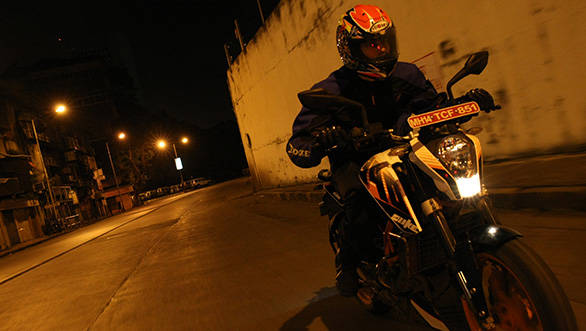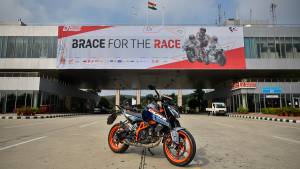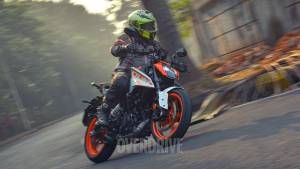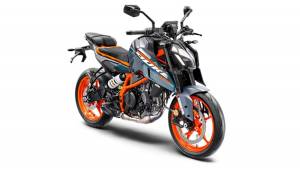KTM 390 Duke: What isn't in the road test
You have already read out road test of the amazing KTM 390 Duke. But the thing about writing crisp road tests is that by design they restrict testers from the space needed to discuss, highlight or when needed criticise the smaller details. So here are the things that I didn't have space to fit in the road test, in graphic, no-holds barred detail.

1. Fuel quality
The issue
The Duke 390's engine is one of the highest compression motors on sale in India on two wheels. Bajaj recommends normal fuels. Should I run premium fuels just to be safe?
The technical explanation
Higher compressions are great for extracting more power and torque from engines but also tend to make them more sensitive to the quality of the fuel employed. Typically, higher compression engines require fuels with higher octane numbers. Some bikes get around this with sensors that can sense the quality of the fuel and adjust the combustion parameters to compensate. This keeps the engine safe even if there is bad fuel inside but usually means the actual power delivered by the engine changes depending on the fuel.
The Duke, thanks to its value pricing doesn't get this fuel quality business so the question is whether the bike will run normal pump gas or not.
The manufacturer says
All of their testing indicates that the bike runs just fine on regular fuels, so premium or high RON fuels aren't really needed. There is always a warning about adulterated fuels and this is true for all internal combustion engines, not just the 390.
We found that...
...the 390 Duke 390 runs fine on regular fuel. OVERDRIVE uses two fuel stations, one in Mahim, Mumbai and one in CBD Belapur, Navi Mumbai for our measured test runs and I use another two on my commute outside of that. During our test, the 390 ran regular petrol from all four pumps and even performance testing was done (as usual) on normal petrol. We didn't notice any difference in the way it delivered power or the feel of the engine at any speed. The one time where the bike was nearly dry and the pump had run out normal fuel, we filled up on Speed and it didn't change the feel or power at all either.
2. The hard seat
The issue
The KTM 200 comes with a rock hard seat and now, the 390 gets that seat too. This is an uncomfortable motorcycle, right?
The technical explanation
A motorcycle seat must offer support to the rider but there's are two other things to note. One, if the seat puts pressure on the tail bone (Hello, Thunderbird 500) it can make itself painfully uncomfortable within a couple of hours of riding. Two, softer seats aren't necessarily great. We have tested a lot of soft seats that work well for short trips. On longer trips, you'll sink to bottom and end up with the seat's base plate trying to carve a groove in your bottom. This doesn't mean there aren't brilliant soft seats but in our experience, hard seats turn out better over time as well as long distances than soft ones. Heck, almost every highly regarded tourer usually has a harder seat than you think. Finally, soft seats by nature lose shape and springiness faster and harder seats tend to retain their qualities for significantly longer.
Also, if you look up high-end bicycle seats, you'll note that they all seem to have a groove running down the middle of it. That groove serves to relieve pressure on a nerve bundle that runs just under the skin between human genitalia and the anus. Pressure on these nerves is a pain in the, well, arse, as you can imagine. The thing is, it is the nerve bundle that leads to umptimillion posts on the Internet that say do not buy gel saddle covers for your bicycle. The logic offered also damns soft seats. It says you'll sink into the softer gel and end up with the nerve bundle under pressure because the sinking in causes the seat to come back into contact with the nerve bundle area. Soft seats probably do the same thing I have no proof, but it makes sense.
The manufacturer says
Well, to be honest, the seat's hardness never comes up. I haven't even seen a mention of the seat either way in any international review so far. Chances are even if it isn't brilliant by their standards, it certainly doesn't do its job so badly that it merits a mention.
We found that...
...the seat is as hard as the 200 but you notice it more on the 390. This is partly because of the harder ride quality and partly because at higher speeds; the 390 is less busy, giving you more time to notice the niggles.
I personally found that the 200 needed a few months to settle in and after that either the seat or your bum, or likely both get used to each other. And I found riding someone else's Duke always made me feel like their seat was different in feel from the one I was usually riding. So I suspect that the hard seat is an initial issue but it solves itself.
Further, the seat comes off with two screws and there are seat makers dime-a-dozen in almost every town and city in India. Which means even if six months later the seat continues to bug you, fixing it should neither be expensive nor hard.
One more thing...
...in terms of long-distance riding, to be honest, the hardness of the seat isn't the big issue. The sources of discomfort are actually the peg position which folds your legs back quite severely for touring and will eventually cause pain. The other is the lack of space. For a reasonably well-fed rider anything more than 5'10" tall, the Duke's fit is exact. Which means in the fourth hour of a ride, you don't have enough space to wriggle around to relieve pressure on your bum. When I last rode the 200 for 1000km in one day, both of these bugged me a lot more than the seat's foam.
3. The hard ride
The issue
The 390's ride is pretty stiff and it is more skittish and jittery over the bumps than even the 200.
The technical explanation
Suspension's primary job isn't as much to keep your body comfortable as it is to ensure that both wheels can follow the contours of the road. Remember that you can only steer the bike if the front wheel is in contact with the road and you can only ride forward if the rear wheel is on the ground.
As motorcycles get more powerful it becomes harder and harder to make them super comfortable while being able to manage the power, both in a straight line and especially around corners. You can easily make a soft setup that can absorb the road but the same setup will tie itself in knots when you try to corner it.
The 390 was never going to be a soft, comfortable motorcycle. If you want a powerful but comfortable motorcycle you are going to have to wait for Honda to bring the CB500 range to India or hope that the Enduro model due in 2015-ish based on the 390 adopts a gentler suspension setup.
The manufacturer says...
...that the bikes that go to places with better roads, like Austria for example, run an even stiffer damping while the Indian setup adopts softer damping to allow it to handle our roads as best as it can.
We found that...
... the ride quality will have to be a personal choice you'll have to make. It is stiff and tightly damped like a sportsbike might be and on good roads and corners, it allows the chassis to come out and dazzle. The flip side is that you'll have to slow right down before bad patches and then ride it out. The bike doesn't ever feel fragile, so it isn't like you'll break stuff over bad roads, but it is going to be a workout for you.
One more thing...
...to note is that you can help yourself. Stand up on the pegs, grip the tank with your knees and keep your legs sightly bent. The Duke feels quite natural in this riding position. If you can finish slowing down before you hit the bumps and then come on the throttle just a little bit while you're on the bumps, you'll find the 390 quite a cheerful, if bouncy partner. This doesn't solve the problem, but it is an effective workaround.
4. Engine heating/overheating
The issue
The 200 is famous for cooking legs in slow traffic. The 390 must be worse, right?
The technical explanation
First of all, a hot engine isn't automatically an overheating engine. A common mistake is to note a number of bars on the temp side of the KTM display and conclude the bike is overheating. It isn't until the warning light comes on and the readout tells your explicitly that there is a problem with the coolant temperature.
Second, powerful engines produce heat. It is how they make power and there is no getting away from it.
Third, the real problem actually isn't the engine heat but the fact that the radiator fan, when it comes on, happens to dump the hot air it is extracting through the radiator fins more or less unerringly onto your legs. That is the real issue, not as much the engine itself.
The manufacturer says...
...that this is a perception issue rather than a problem for the motorcycle. And this perception issue isn't just common to the Duke either. The Ninja 300, for instance, gets a duct inside the fairing that directs radiator exhaust down below the engine itself to ensure the rider doesn't, literally, feel the heat.
We found that...
... the 390 engine actually runs a bit cooler than the 200 in daily use because you're using less revs everywhere. It makes a small difference but you will feel the heat at some point or the other. A win-win solution is to ditch the denims and switch to full on riding pants. Regular denim is useless for protection in crashes to start with. Motorcycle riding pants looks cool, feel great on the bike, come with waterproof liners, protect you in crashes and make you look like a serious rider as well. And on a Duke, they'll resist tandoori legs for longer.
5. Starting troubles?
The issue
Some Facebook reports are already suggesting that the Duke has a starting issue.
The manufacturer says
We spoke to a KTM service in-charge, who told us that new bikes have a minor problem where the decomp delays the ignition on a hot engine. It is a problem they expect will solve itself once the engine gets a little more miles on it.
We found that...
...the Duke never fails to start on a single press of the button when cold. Once hot though, it continues to start every single time but the starter motor takes longer to wake it up. Please let us know if your experience is different in the comments. But as of now, we are classifying this is a mild annoyance rather than a deal-breaker.
6. The nature of the beast
The issue
We know of many readers who were put off by the nature of the Duke 200. Is the 390 more of the same?
We found that...
...KTM seems to revel in making these rock hard, unforgiving, challenging motorcycles. In that sense, for example, they are a direct counterpoint to Honda's motorcycles which tend to be gentler, forgiving and in that sense easier to live with.
The 390 is a little calmer than the 200. This is because it makes more power at all revs which means the engine delivers torque without requiring you to perpetually be three clicks from the redline. The broader power also allows the more spread out gear ratios that further reduce the frenetic gear changes required to keep a 200 on the boil. But combine this with the sharp chassis, the stiff ride and extremely quick reactions and it still is a manic motorcycle.
The telling difference is that, for example, the CBR250R feels like a calm, large machine which enhances your confidence in it. The KTM 390 feels like a sharp, small machine with big power which - and this is the critical bit - requires you to have the confidence to take it on. It is a big shift in perspective and this is the reason why some of you will appreciate the 390, be willing to borrow it off a friend now and then, but never consider buying one. This, is why we say the 390 is brilliant, but not for everyone.
7. Waiting for choice
The issue
The choice seems to be 390 or bust if I want a powerful motorcycle.
We found that...
...this is true for the moment, although other bikes like the CBR250R do offer a reasonable alternative, at least in city traffic where the extra power is harder to use.
But if you are willing to wait, KTM itself will offer the RC390 sometime next year, Bajaj will have a calmer, more useable, less expensive Pulsar based on it as well. Honda also has a rumoured CBR300R being readied as a model change for the CBR250R and we expect that bike to come to India, and there are persistent rumours that Honda will also bring the CB500 family in at some point. Also in the pipeline are enthusiast-oriented Suzuki's and of course, in 2015 the TVS-BMW developed bikes to be sold under their individual brands. So the choice is limited for now, but all you have to do really, is wait just a bit longer.
Starts Rs 2,52,928
373cc
6-Speed
43.50
37.00
25.00 Kmpl














